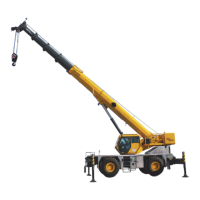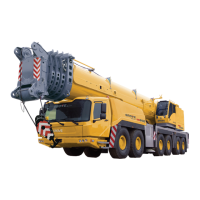OPERATING PROCEDURES GRT655/655L OPERATOR MANUAL
4-18 Published 3-23-2020, Control # 654-04
Traveling with Elevated Boom
Exercise caution whenever driving crane with boom
elevated. Travel with the boom elevated is permitted as long
as the following steps are followed.
• Limit travel to firm, level surfaces (if traveling on slopes,
follow the requirements under the section Traveling on
Slopes, page 4-15).
• Inspect route of travel before moving crane. Pay
particular attention to any changing conditions of terrain
being traversed. Avoid any overhead obstructions.
• Travel must be performed in a controlled fashion.
• Do not exceed a speed of 24 km/h (15 mph).
• Inflate tires to recommended pressure for travel
operations.
• When using towing attachments, boom must remain
horizontal.
• Fully retract all boom sections.
• Refer to Traveling with Boom Extension Erected,
page 4-18 if boom extension is in the erected position.
• Position boom over front of crane.
• Engage swing brake and turntable lock pin.
• Hook block may be reeved over the main boom nose.
Overhaul ball may be reeved over the main boom nose
or auxiliary boom nose. Block and ball may be
suspended below the boom nose. It is also acceptable to
secure the block or ball to carrier tie down point to
prevent swinging if necessary.
• Limit boom angle to a maximum of 20°.
• Do not support any load from the boom (see Pick and
Carry Load chart for limitations for this application).
• Remove all cribbing or other non-standard accessories
from crane.
• Avoid holes, rocks, extremely soft surfaces and any
other obstacles that might subject crane to undue
stresses and possible overturn.
• Make sure adequate clearance to any overhead
obstructions crane may be required to travel beneath.
• Make sure all personnel involved in the operation and
those working around crane are aware of any hazards
that may be encountered and are trained how to avoid
them.
Traveling with Boom Extension Erected
• Stinger section shall be pinned in the fully retracted
position.
• Main Boom shall be fully retracted.
• 7.92 m (26 ft) boom extension shall be erected at
minimum (0 deg) offset.
• Jobsite travel shall be only on firm, level surface (if
traveling on slopes, follow the requirements under the
section Traveling on Slopes, page 4-15).
• Maximum travel speed: 2.5 mph.
• Main boom angle shall be between 0 degree and 30
degrees.
• Counterweight shall be installed.
• Auxiliary hoist or IPO counterweight must be installed.
• Boom shall be directly over front. Swing lock shall be
engaged.
• Tires shall be properly inflated.
• RCL shall be programmed to On Rubber, Pick and
Carry, Boom Centered Over Front.
• Hook block must be removed from main boom nose.
• Overhaul ball may be reeved over boom extension,
hanging 0.9 m (3 ft) below sheave.
Extended Travel
Depending upon the tire manufacturer, the higher inflation
pressures normally specified for lifting on rubber are not
recommended for site to site traveling over extended
distances. The higher static/creep 8 kph (5 mph) inflation
pressures may remain in the tire while operating the crane
on site within a distance of less than 6.4 km (4 mi).
WARNING
Overhead Objects Hazard
Contacting overhead objects while driving crane may
result in death, severe injury, and/or equipment damage.
Traveling with boom elevated should only be attempted
under controlled conditions specified in this section.
CAUTION
Tire Damage Hazard!
For extended travel, check cold tire pressure before start.
(Refer to tire inflation chart in Load Chart Book.) After
every one hour of travel time, regardless of ambient
temperature, stop and allow tires to cool for at least 30
minutes. At destination, tires must be allowed to cool to
ambient temperature before crane lifting on rubber.

